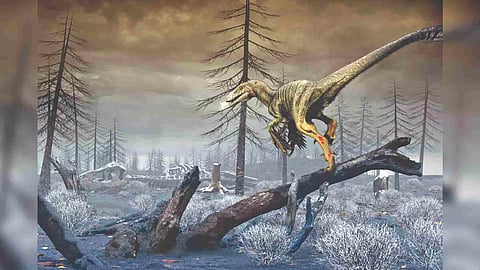

MIRIAM FAUZIA
On a spring day over 66 million years ago, an asteroid slammed into the sea just off the coast of modern-day Mexico. Known as the Chicxulub impact, it set off a global shock wave, earthquakes and mega-tsunamis that exterminated the non-avian dinosaurs and plunged Earth into a long and dark winter.
A study published Monday in the journal Nature Geoscience has uncovered a cause of this cold snap: dust. The study’s authors say that micrometer-size fine silicate dust lingered as long as 15 years in the atmosphere after the impact and contributed to the global cooling. Additionally, they say, all photosynthetic activity on Earth may have ceased completely within two weeks following the Chicxulub impact largely because of fine dust.
Stephen Brusatte, a paleontologist at the University of Edinburgh who was not involved in the research, said studies like this one aided understanding of the time period after the asteroid’s impact.
“They help us empathize with T. rex, Triceratops and the other dinosaurs that woke up in the morning on the top of the food chain but by the end of the day were facing a world in chaos,” he said.
During fieldwork in 2017, Pim Kaskes, a geologist at Vrije Universiteit Brussel in Belgium and an author of the new research, collected some fine-grained samples from a geological formation in North Dakota known as Tanis, which yielded a treasure trove of fossils. While Tanis is 2,000 miles from the Chicxulub impact, seismic waves created a deposit of minerals known as the Cretaceous-Paleogene boundary. It is about four feet thick and corresponds to the event.
He shared the samples with Cem Berk Senel, a paleoclimate modeling researcher at the Royal Observatory of Belgium who was then a graduate student at Université Libre de Bruxelles.
“One of the key questions we wondered was what was the primary governor of the Chicxulub mass extinction event because, in the literature, there have been diverse hypotheses addressing this phenomenon,” Dr. Senel said.
The role of dust has often been overlooked. Instead, scientists have focused on sulfur particles that rocks released after the asteroid vaporized them, as well as soot from the impact and subsequent wildfires.
“The effects of the dust were not well known,” Dr. Kaskes said. “Most of the work that has been done used very coarsegrained material that rains very rapidly out of the atmosphere or extremely fine particles that also rain down relatively quickly.” The sulfur and soot, he said, were hypothesized to be better at absorbing and blocking sunlight compared with dust and thus the likely harbingers of the impact winter.
According to Dr. Senel’s computer simulations, which incorporated data from sulfur particles, soot and the measurements from Dr. Kaskes’s samples, fine dust was a climate heavy hitter. In the asteroid’s aftermath, a cloud of fine dust thinner than a strand of hair clung to the atmosphere. Unlike sulfur and soot, which disappeared over time, these particles stayed put for at least 15 years. This led global average surface temperatures to plummet by as much as 59 degrees Fahrenheit.
Miriam is a journalist with NYT©2023